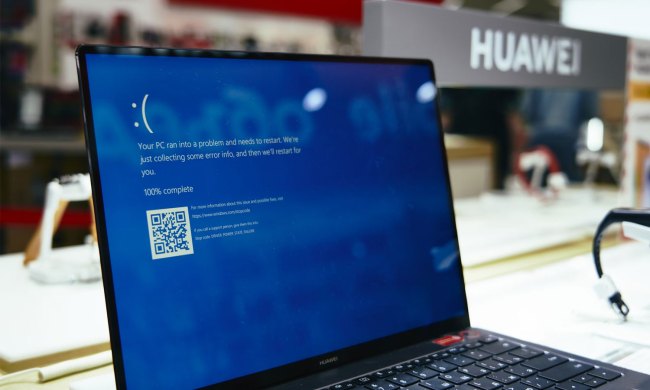Intel hasn’t had it easy as of late. Though it remains king of PC processors, growth has stagnated, forcing the company to compete in new areas. We’ve seen it dabble all over the last few years: the cloud, robots, wearables, connected appliances, automation, 3D cameras, and much more. Often, the demos feel a bit half-baked.
This year’s Intel Developers Forum, which kicked off Tuesday, was different.
Intel has decided to elbow into virtual reality, one of tech’s hottest trends. And the technology it showed off is more game-changer than gimmick.
It was all building up to this
RealSense, Intel’s 3D camera technology, has existed for several years, and the company has tried time and time again to re-frame it in the context of new technologies — with limited success. While it seems a promising way give drones perception of their surroundings, it has never taken off in PCs, tablets, or smartphones.
Intel has flipped the script for building a VR headset.
It’s time to forget all that. Virtual reality is booming, and RealSense gives Intel a unique new tool in the space. To prove it, Intel took the wraps off Project Alloy headset at Intel Developer Forum 2016 in San Francisco.
Alloy flips the current script for building a VR headset. Front-runners like HTC’s Vive and Oculus’ Rift work by using external sensor stations to track the your headset and controllers. Intel eliminates these by instead using a RealSense camera. It scans the world around you to understand how you’re moving through a room. Better still, the camera can track your hands, so you can interact with virtual objects naturally.
That’s a big deal. Suddenly, room-scale VR becomes possible without any of the tedious installation and setup, and without controls you may accidentally fling across the room.
Alloy even allows real objects to bleed into the virtual realm. You can see your real hands — or your cat, just moments before your trip over her. In essence, it’s a superior version of the Vive’s chaperone system, which works well but doesn’t provide the same level of detail.
Not ready for consumers, but that’s OK
Intel didn’t provide an exact release date or pricing for Alloy, and said that it won’t be out until late 2017. That may seem an annoying delay, but it matters less than it seems.
Alloy isn’t something Intel wants you to find on the shelf at Best Buy. It’s a development tool.
Alloy, like a lot of products built by Intel, is not being designed to compete with the Rift or Vive directly. Instead, it’s appealing to Oculus and HTC, showing each an alternative way to build their hardware — with Intel inside.
Intel does this all the time. In the past the company has shown laptop testbeds, the Next Unit of Computing, wearable bracelets, and more. Often, these “products” are never actually sold. Even when they are – as with the Next Unit of Computing – they’re barely advertised.
This may seem a silly tactic, but it works. Just have a look at the hordes of NUC and Compute Stick look-alikes that swarm Amazon, Newegg, and Alibaba. Even the modern 2-in-1 notebooks built by Dell, HP, and others owe a lot to early design prototypes built by Intel and shown at major press events.

It’s important to understand Alloy’s really purpose. Taken on its own, it’s not hard to criticize. While no one has had hands-on time with it yet, it’s clearly a large device, and probably quite heavy. We don’t know anything about its latency, its resolution, or the power of the compute hardware Intel says is inside it. I suspect that, despite its advanced technology, the experience of using Alloy is quite far behind the Rift and Vive.
But that’s not the point. Alloy isn’t something Intel wants you to find on the shelf at Best Buy. It’s a development tool used to illustrate the potential of its own technology, when properly used. In that context, Alloy is the coolest project Intel has shown in years.
The next step
Though Project Alloy stole the show at IDF 2016, it was just part of a broader platform of development sessions conducted during the conference. A number of technical sessions covered a range of topics, including ideas for taking VR mainstream and the “sensification” of VR.
As always, Intel has a horse in this race. The company seems to be pushing for solutions that include some kind of processor in the headset to offload certain tasks, like calculating a headset’s position in a room. Intel would love for VR developers to decide they need an Atom or Core chip inside their headset to accelerate the experience.
That may prove a stretch. But Intel’s not entirely selfish. The company has always proven capable of working with partners to push new standards, from USB to Thunderbolt. Virtual reality is no different. Intel, in partnership with Microsoft and others, is expected to publish a new base-level set of recommended specifications for enabling “merged reality” experiences. And that’s just one initiative of many.
I’m excited to see Intel embrace virtual reality, and augmented reality, in a big, comfy bear hug. The company’s previous mentions of the topic were bare bones – usually nothing more than a reminder that Intel processors are best for gaming rigs built power the Rift and Vive. But at IDF 2016, Intel committed fully to the VR revolution, and it will prove a powerful ally.


